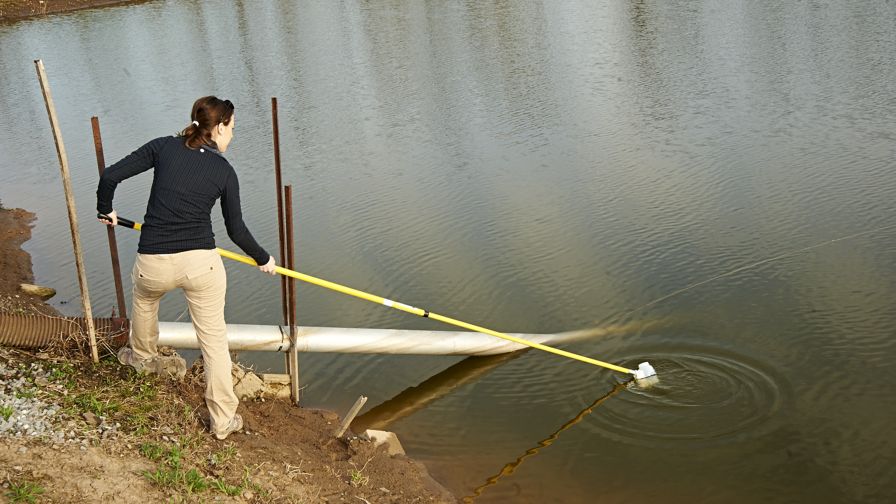Get to Know Your Greenhouse Water

Try to sample from locations that are close to where the water enters the production area (e.g. in the first few rows or benches) and those that are near the end of the line to get a better idea of the problems you might be facing.
Editor’s note: Before you read the article below, be sure to check out the Irrigation Technology Annual Report, which features a closer look at how greenhouse irrigation automation is advancing, even with hurdles.
Pathogens can quickly accumulate and spread in your greenhouse irrigation source, and when unchecked, the results can be devastating. Fortunately, there are steps you can take to make sure your water is free from harmful materials.
In a recent series on OnFloriculture.com, Dr. Sarah Jandricic, a Greenhouse Floriculture IPM Specialist, and Dr. Chevonne Dayboll, Greenhouse Floriculture Specialist, with the Ontario Ministry of Agriculture, Food and Rural Affairs, offers critical advice for growers on testing and treating their water supply. Here are just a few insights they offer.
The Do’s and Don’ts of Sampling Your Water
You can find several tips on how to monitor, interpret, and solve chemical issues for water used to irrigate greenhouses and nurseries in a YouTube video produced by Dr. Paul Fisher from the University of Florida’s Institute of Food and Agricultural Sciences. The video is part of a series called “Five Tips for Horticulture” featured on the university’s Greenhouse Training Online channel.
Regarding when, where, and how to sample, Jandricic and Dayboll recommend you consider the following Do’s.
- DO monitor at frequencies that relate to the level of risk. These include different points in the production cycle (especially before a new crop goes in); when there are changes in source water quality occur (e.g., switching from roof water to water stored in a cistern), when sensitive crops are present (based on crop type and/or stage; this is why knowing your crop’s susceptibility to diseases before you plant is so important); and when labor is available.
- DO sample from all sources of water and from various points along your irrigation system. This can reveal potential sources of contamination and gives you a picture of how pathogens are spreading throughout your farm. Testing along your irrigation system can also reveal issues with water pressure and distribution that may be causing wet or dry spots in the crop, which can also lead to disease problems. Try to sample from locations that are close to where the water enters the production area (e.g., in the first few rows or benches) and those that are near the end of the line to get a better idea of the problems you might be facing.
- DO sample recirculating water before and after water treatment. This tells you if your chosen water treatment strategy is actually working like it’s supposed to. Never assume that it’s functioning properly. All systems need maintenance and some need proper levels of active ingredient(s) to work, which can change frequently depending on the amount of organic matter in the system. Be safe, and follow a regular testing schedule to maintain your investment.
- DO follow the guidelines suggested by your chosen lab. Many labs have specific guidelines for collecting water samples as well as general shipping/handling guidelines. Make sure to read over these thoroughly before collecting and sending samples. In a pinch, you can use disposable water bottles to collect samples, but ensure they are rinsed with your source water well before taking a sample. Never use vessels that were used for another purpose (e.g., scoops for mixing fertilizer) to grab samples, as they may leave residue in your sample that can affect your results.
- DO have a consultant or specialist help you interpret the results of any tests. They can help you figure out which pathogens are pests of concern, and what to do about them.
What not to do can be as important as what to do. Consider these don’ts and make sure to think of others that may apply to your own farm.
- DON’T leave sampling until the last minute. Sampling should be a proactive activity, not a reactive one. But if you’re like many of us, a lack of time and too much on your plate can mean that your water samples are taken after crops have gone in, or you spot something that isn’t right. Schedule regular water sampling into your calendar and make sure it gets done ahead of sensitive crop cycles or your big spring season.
- DON’T be afraid to send in several samples at once, despite the cost. Whether you like to do a more thorough check of your irrigation systems twice a year, or you are facing a problem and don’t know where to start, more samples can help you pinpoint a problem more accurately in the greenhouse, saving you time and headaches.
- DON’T forget to factor in costs of regular sampling into your pest management costs. DNA tests that sample for potential pathogens down to species cost around $250 (Canadian) per sample. This is a drop in the bucket compared to the crop losses you might see due to pathogens in recirculating water, so make room for them in your pest control budget.

It’s important to sample from all sources of water, and from various points along your irrigation system. Photos: OMAFRA
The Pros and Cons of DNA Tests
Even with disease symptoms present, it can be difficult to nail down which pathogen is the culprit (and which fungicide will work), without a DNA test.
Overall, DNA tests are the gold standard, for many reasons:
- DNA doesn’t lie. It’s surprising how much symptoms from one disease look like another; even an expert with years of experience can make a mistake when it comes to diagnostics from just signs and symptoms, especially with diseases that cause root rots. With DNA tests, you can be sure.
- They can screen for multiple pathogens, including ones you might not have even considered.
- Multiple samples can determine where a problem is coming from. If you take samples from multiple points along your water system, and disease issues are only detected in one area (e.g., a secondary holding tank), or are especially high in one area, this can narrow down the source of the problem. This can potentially save you thousands of dollars in crop losses and unnecessary fungicide application by eliminating recurring disease issues at the source.
Despite the benefits of DNA analyses, as with any tool, they aren’t perfect. They require some know-how (or asking experts) to provide correct interpretation of results. You still need to be an investigator of sorts, and use your DNA results, plus other pieces of information, to come to the right conclusions.
Here are some things to keep in mind when interpreting a DNA test:
- Look for specific pathogenic species on the results output. For example, positive test results for Fusarium on DNA results without indicating an actual species are likely false leads, since there can be beneficial or non-disease causing species of Fusarium. You want to look for specific species known to cause disease e.g. Fusarium oxysporum. Positive DNA tests results for an actual pathogenic species from your water and/or a diseased plant, paired with matching disease descriptions of symptoms in your crop (from an accredited source), together, strongly suggest a specific culprit.
- Be cautious of low versus high pathogen loads on DNA test results. Although it can be tempting to go down the list of positive results on a DNA scan and assume that the results that came back at the highest levels are the true culprit, it doesn’t always work this way. Some pathogens are often present at low levels (like Pythium) without causing disease, and other pathogens cause significant disease at very low pathogen loads. For example, a positive result for Thielaviopsis basicola (black root rot), high or low, from a plant or water sample in a greenhouse that grows susceptible crops might mean the grower should put on a preventative fungicide application. Black root rot produces resting spores that are hard to kill and are easily spread, and can cause infection at even low levels.
- Be aware that DNA analyses can’t tell you if a pathogen is alive or dead. They just pick up DNA fragments (sort of like crime-scene tests). So you may need more than just a DNA test to go on.
- Understand that DNA tests can’t directly tell you if your treatment is working or not. Testing your water before and after water treatment may show differences in pathogen loads, but without knowing if the pathogens survived the water treatment, that’s not much use.
- Know that DNA analyses can be paired with more specific tests to help determine water treatment efficacy. For example, if you run a test on your water and multiple pathogenic species come back positive on the test, you may want to ask the lab to try to plate or grow suspected pathogens pre/post water treatment on specific media. Plating makes sure a specific pathogen found in your recirculating water is actually alive, and has the potential to cause issues.









